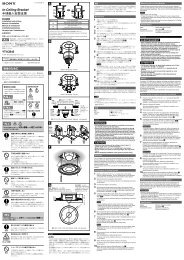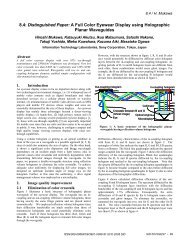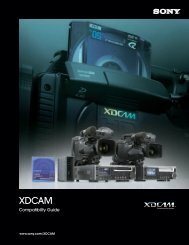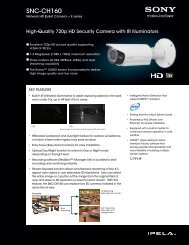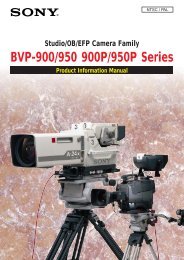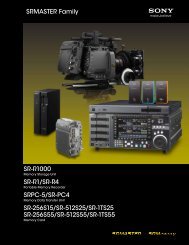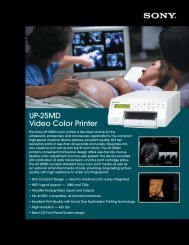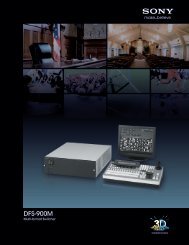The world of Jim Slater visited the Sony Technology Centre at Atsugi ...
The world of Jim Slater visited the Sony Technology Centre at Atsugi ...
The world of Jim Slater visited the Sony Technology Centre at Atsugi ...
You also want an ePaper? Increase the reach of your titles
YUMPU automatically turns print PDFs into web optimized ePapers that Google loves.
DIGITAL SONY 4K WORLD<br />
<strong>Jim</strong> <strong>Sl<strong>at</strong>er</strong><br />
<strong>visited</strong> <strong>the</strong> <strong>Sony</strong><br />
<strong>Technology</strong> <strong>Centre</strong><br />
<strong>at</strong> <strong>Atsugi</strong> and <strong>the</strong><br />
4K Digital Cinema<br />
projector factory in<br />
Kosai, Japan<br />
<strong>The</strong> <strong>world</strong> <strong>of</strong><br />
<strong>The</strong> itinerary for <strong>the</strong> trip had been<br />
carefully worked out beforehand in<br />
conjunction with Basingstoke-based<br />
Josh Honda, Senior Manager <strong>of</strong> <strong>the</strong><br />
European Digital Cinema and Signage group, so<br />
as to maximise both wh<strong>at</strong> we could be shown<br />
and <strong>the</strong> opportunities for discussion, and I was<br />
delighted to be accompanied throughout <strong>the</strong><br />
trip by Mark Clowes, Marketing Manager for<br />
Digital Cinema. On arrival in Japan we were<br />
joined by ano<strong>the</strong>r well known journalist in <strong>the</strong><br />
Digital Cinema field, Bill Mead, who runs <strong>the</strong><br />
acclaimed www.DcinemaToday.com website<br />
and contributes technical articles to Film<br />
Journal Intern<strong>at</strong>ional. <strong>The</strong> four <strong>of</strong> us rapidly<br />
discovered how much experience we had in<br />
common, and for <strong>the</strong> next three days we never<br />
seemed to stop talking!<br />
Monday morning saw us taking an hour and<br />
half train ride from Yokohama to <strong>the</strong> impressive<br />
<strong>Sony</strong> <strong>Technology</strong> <strong>Centre</strong> <strong>at</strong> <strong>Atsugi</strong>, a sizeable<br />
campus with several large buildings, which is<br />
<strong>the</strong> largest <strong>Sony</strong> Research and Development<br />
site <strong>world</strong>wide. Key research areas include<br />
m<strong>at</strong>erials, display devices, core technology<br />
developments, and inform<strong>at</strong>ion technologies,<br />
and <strong>the</strong> centre has been <strong>at</strong> <strong>the</strong> heart <strong>of</strong> many<br />
technology breakthroughs, mainly for <strong>the</strong><br />
broadcast industry, since it opened, originally as<br />
a factory, in 1960.<br />
<strong>Sony</strong> United - <strong>the</strong> holistic approach<br />
Shigeo Saito, General Manager <strong>of</strong> <strong>the</strong> Digital<br />
Cinema Department, had assembled a team <strong>of</strong><br />
senior managers covering all <strong>the</strong> areas which<br />
we had indic<strong>at</strong>ed th<strong>at</strong> we might like to discuss,<br />
and he opened his present<strong>at</strong>ion by explaining<br />
how <strong>the</strong> many different facets <strong>of</strong> <strong>the</strong> <strong>Sony</strong><br />
company and <strong>the</strong> many different businesses<br />
which it is made up <strong>of</strong> - ‘<strong>Sony</strong> United’ was <strong>the</strong><br />
expressive phrase he used - all work toge<strong>the</strong>r<br />
for <strong>the</strong> good <strong>of</strong> <strong>the</strong> whole. He took us through<br />
cinema technology • september 2010 • www.cinem<strong>at</strong>echnologymagazine.com<br />
SONY 4K<br />
I am well used to travelling to<br />
different loc<strong>at</strong>ions for Cinema<br />
<strong>Technology</strong> magazine, but a recent<br />
invit<strong>at</strong>ion from <strong>Sony</strong> to talk<br />
with <strong>the</strong>ir top technical people<br />
and to visit <strong>the</strong>ir digital cinema<br />
projector factory in Japan<br />
broke all <strong>the</strong> records - with <strong>the</strong><br />
five day round trip approaching<br />
13,000 miles, I reckon th<strong>at</strong> must<br />
be about a mile for every word<br />
<strong>of</strong> <strong>the</strong> resulting CT articles.<br />
<strong>the</strong> business to business areas, showing how<br />
<strong>the</strong> Visual Present<strong>at</strong>ions Solutions division<br />
includes projectors, displays and, to my<br />
surprise, pr<strong>of</strong>essional special purpose printers<br />
- <strong>the</strong>y are all ‘output devices’, as he explained.<br />
<strong>The</strong> aim <strong>of</strong> <strong>the</strong> digital cinema business is to<br />
provide high quality digital images right through<br />
<strong>the</strong> chain from acquisition to exhibition, in<br />
parallel with ensuring innov<strong>at</strong>ive workflow<br />
methods which can lead to cost reductions.<br />
<strong>The</strong> history <strong>of</strong> 4K<br />
<strong>The</strong> history <strong>of</strong> <strong>the</strong> development <strong>of</strong> <strong>the</strong> <strong>Sony</strong><br />
4K projector was explained in detail, with <strong>the</strong><br />
first 4K business (d<strong>at</strong>a) projectors such as <strong>the</strong><br />
SRX-R110 appearing in 2005. <strong>The</strong> substantially<br />
larger high-brightness Digital Cinema<br />
projectors, SRX-R220 and 210 came to market<br />
during <strong>the</strong> next couple <strong>of</strong> years. <strong>The</strong> current<br />
Digital Cinema model, <strong>the</strong> more compact SRX-<br />
R320 came to market in 2009, effectively <strong>the</strong><br />
third gener<strong>at</strong>ion <strong>of</strong> <strong>Sony</strong>’s 4K projector line,<br />
and <strong>the</strong>re is also a complete range <strong>of</strong> business<br />
projectors and a very high-brightness noncinema<br />
projector <strong>the</strong> SRX-T420 which is used<br />
in applic<strong>at</strong>ions such as Visualis<strong>at</strong>ion, Simul<strong>at</strong>ion<br />
and large venue events /exhibitions. Audi,<br />
Jaguar Land Rover and o<strong>the</strong>r key automotive<br />
manufacturers all benefit from <strong>the</strong> <strong>Sony</strong> 4K<br />
high resolution to speed up <strong>the</strong>ir costly design<br />
process.<br />
Common pl<strong>at</strong>form - common<br />
development<br />
<strong>The</strong> various projector ranges are based on<br />
a common technology pl<strong>at</strong>form using <strong>the</strong><br />
SXRD (Silicon Crystal Reflective Display)<br />
chip which is designed and developed <strong>at</strong> <strong>the</strong><br />
<strong>Atsugi</strong> <strong>Technology</strong> <strong>Centre</strong>, with <strong>the</strong> display<br />
chips actually being manufactured in <strong>the</strong> <strong>Sony</strong><br />
semiconductor factory <strong>at</strong> Kumamoto in <strong>the</strong><br />
south <strong>of</strong> Japan. Keeping everything in house,<br />
from chip manufacture through to <strong>the</strong> final<br />
projector manufacture is regarded as a gre<strong>at</strong><br />
strength <strong>of</strong> <strong>the</strong> <strong>Sony</strong> DC projectors, whereas<br />
competing DLP Cinema® projectors are made<br />
by several o<strong>the</strong>r manufacturers who have to<br />
buy in <strong>the</strong> essential light-engine components<br />
from semiconductor manufacturer Texas<br />
Instruments and build <strong>the</strong>se into <strong>the</strong>ir own<br />
projector designs.<br />
SXRD basics<br />
<strong>The</strong> technology <strong>of</strong> <strong>the</strong> SXRD chip design was<br />
explained in some detail and it was shown<br />
how <strong>the</strong> 1.55 inch diagonal display chip can<br />
be manufactured with extremely small (0.35µ<br />
- micron) gaps between <strong>the</strong> pixels. Such small
Polarised<br />
light out<br />
to panel<br />
Light input<br />
SXRD Panel<br />
Pre-polarising beam splitter<br />
PBS polarises <strong>the</strong> light prior<br />
to reaching <strong>the</strong> SXRD panel.<br />
A similar external polarised unit<br />
is used on <strong>the</strong> reflected beam output from <strong>the</strong><br />
SXRD panel<br />
inter-pixel gaps give an aperture r<strong>at</strong>io <strong>of</strong> over<br />
92%, increasing <strong>the</strong> efficiency <strong>of</strong> <strong>the</strong> reflected<br />
display, minimising light leakage between <strong>the</strong><br />
pixels and increasing <strong>the</strong> contrast <strong>of</strong> <strong>the</strong> final<br />
display.<br />
Liquid crystal displays use three elements to<br />
modul<strong>at</strong>e <strong>the</strong> passage <strong>of</strong> light: a pre polariser, a<br />
rot<strong>at</strong>ion medium and a post polariser.<br />
Prior to <strong>the</strong> light reaching <strong>the</strong> SXRD panel it<br />
is pre-polarised by being reflected from an<br />
external Polarised Beam Splitter (PBS).<br />
At this point it is oriented in line with <strong>the</strong><br />
crystal alignment in <strong>the</strong> SXRD imager. <strong>The</strong> prepolarised<br />
light beam <strong>the</strong>n passes through <strong>the</strong><br />
vertically aligned SXRD liquid crystal m<strong>at</strong>erial<br />
which sets <strong>the</strong> final polarity. This is a special<br />
vertically aligned design specific to SXRD.<br />
Within <strong>the</strong> SXRD panel, <strong>the</strong> light reflects <strong>of</strong>f<br />
<strong>the</strong> surface <strong>of</strong> <strong>the</strong> Silicon backplane and back<br />
towards <strong>the</strong> PBS. If <strong>the</strong> SXRD pixel has rot<strong>at</strong>ed<br />
<strong>the</strong> light, it is <strong>the</strong>n not aligned with <strong>the</strong> post-<br />
PBS orient<strong>at</strong>ion and is allowed to pass. If <strong>the</strong><br />
incoming light has not been rot<strong>at</strong>ed, <strong>the</strong>n it is<br />
reflected within <strong>the</strong> PBS back into <strong>the</strong> source<br />
light p<strong>at</strong>h.<br />
<strong>The</strong> SXRD panel uses a production process th<strong>at</strong><br />
<strong>Sony</strong> has perfected over <strong>the</strong> years in its own<br />
dedic<strong>at</strong>ed manufacturing facility <strong>at</strong> Kumamoto,<br />
allowing everything to be manufactured to <strong>the</strong><br />
highest <strong>of</strong> quality standards. No semiconductor<br />
manufacturer will talk about yields, but I<br />
gained <strong>the</strong> impression th<strong>at</strong> <strong>the</strong> <strong>Sony</strong> process is<br />
well under control, and th<strong>at</strong> manufacturing a<br />
range <strong>of</strong> SXRD chips for different equipment<br />
has long been routine. I asked whe<strong>the</strong>r <strong>the</strong><br />
semiconductor development had come to a<br />
halt, but was told th<strong>at</strong> <strong>the</strong>re is a continuing<br />
process <strong>of</strong> development and improvement <strong>of</strong><br />
both <strong>the</strong> chips and <strong>the</strong> manufacturing methods<br />
<strong>at</strong> <strong>Sony</strong> semiconductor, and we were given<br />
examples <strong>of</strong> where improvements to <strong>the</strong><br />
manufacturing process had given rise to more<br />
reliable oper<strong>at</strong>ion.<br />
In <strong>the</strong> SXRD panel, light from <strong>the</strong> lamp enters through <strong>the</strong> glass substr<strong>at</strong>e <strong>at</strong> <strong>the</strong> top, passes through <strong>the</strong> Liquid<br />
Crystal layer, reflects <strong>of</strong>f <strong>the</strong> mirrored surface <strong>of</strong> <strong>the</strong> Silicon backplane, <strong>the</strong>n passes out through <strong>the</strong> Liquid Crystal,<br />
toward <strong>the</strong> lens and screen.<br />
Not just <strong>the</strong> projector<br />
<strong>The</strong> team were keen to stress th<strong>at</strong> <strong>the</strong>ir Digital<br />
Cinema <strong>of</strong>fering doesn’t stop with <strong>the</strong> projector,<br />
but includes a built in media block, with all<br />
<strong>the</strong> security advantages th<strong>at</strong> this can provide, a<br />
library server, touch panel and a range <strong>of</strong> lenses<br />
suitable for all cinemas.<br />
<strong>The</strong> projectors have been designed to accept<br />
a range <strong>of</strong> Xenon lamps from different<br />
manufacturers, which means th<strong>at</strong> cinemas can<br />
choose <strong>the</strong> best and most economical lamp<br />
for <strong>the</strong>ir situ<strong>at</strong>ion, and th<strong>at</strong> companies who<br />
already have contracts with particular lamp<br />
manufacturers for <strong>the</strong>ir existing projectors can<br />
continue to use <strong>the</strong> same source when <strong>Sony</strong><br />
Digital Cinema projectors are installed - this<br />
type <strong>of</strong> flexibility can <strong>of</strong>ten prove decisive<br />
when contracts are being negoti<strong>at</strong>ed.<br />
<strong>The</strong> hardware is complemented by a<br />
range <strong>of</strong> s<strong>of</strong>tware developed in-house<br />
but in conjunction with users - cinema<br />
managements and technicians. We were<br />
told how <strong>the</strong> s<strong>of</strong>tware systems involved with<br />
<strong>the</strong> TMS (<strong>The</strong><strong>at</strong>re Management System), <strong>the</strong><br />
SMS (Screen Management System) and <strong>the</strong><br />
Cinew<strong>at</strong>ch projection monitoring system are<br />
continuously under development and how<br />
feedback from cinema oper<strong>at</strong>ors is used to<br />
Index M<strong>at</strong>ching Indium-Tin-<br />
Oxide (IMITO) Glass<br />
Substr<strong>at</strong>e<br />
Vertically Aligned Nem<strong>at</strong>ic<br />
Liquid Crystal<br />
Inorganic Alignment Layers<br />
Silicon Backplane<br />
make systems more usable - <strong>the</strong> Graphical<br />
User Interface is a good example <strong>of</strong> part <strong>of</strong> <strong>the</strong><br />
system th<strong>at</strong> has benefited from customer input<br />
and feedback. We were given some ideas as to<br />
future improvements th<strong>at</strong> are being considered<br />
by those actually working in this area, and it<br />
was interesting to discuss with <strong>the</strong> engineers<br />
responsible for writing <strong>the</strong> relevant s<strong>of</strong>tware<br />
<strong>the</strong>ir longer term plans for an ‘Enterprise TMS’<br />
pre-show system th<strong>at</strong> will also look after DCP<br />
deliveries and tie everything in with booking<br />
management, point <strong>of</strong> sale and signage systems.<br />
<strong>The</strong> <strong>Sony</strong> engineers were obviously proud <strong>of</strong><br />
<strong>the</strong>ir LMT-300 4K media block, which is builtin<br />
to <strong>the</strong> SRX-R320 projectors. Containing JPEG<br />
2000 decoding equipment and 1.7 Terabytes <strong>of</strong><br />
storage, <strong>the</strong>y told us th<strong>at</strong> <strong>the</strong> <strong>Sony</strong> equipment<br />
is now recognised by many in <strong>the</strong> cinema<br />
business as a real competitor for <strong>the</strong> server<br />
units made by <strong>the</strong>ir perhaps better known<br />
competitors in this field.<br />
<strong>The</strong> leader in 4K<br />
Although <strong>Sony</strong> were l<strong>at</strong>e to <strong>the</strong> Digital Cinema<br />
market compared with <strong>the</strong>ir DLP competitors,<br />
<strong>the</strong>ir initial marketing to cinema owners<br />
was based on <strong>the</strong> ‘we waited until we could<br />
provide you with <strong>the</strong> best quality images, and<br />
<strong>The</strong> <strong>Sony</strong> LMT-300 Media Block forms an integral part <strong>of</strong> <strong>the</strong> <strong>Sony</strong> Digital Cinema projectors<br />
www.cinem<strong>at</strong>echnologymagazine.com • cinema technology • september 2010
th<strong>at</strong> means 4K’ story, which had something <strong>of</strong> a<br />
ring <strong>of</strong> truth about it <strong>at</strong> <strong>the</strong> time, but with only<br />
a small number <strong>of</strong> projectors established in<br />
<strong>the</strong> marketplace <strong>the</strong> choice <strong>of</strong> system was yet<br />
ano<strong>the</strong>r headache for <strong>the</strong> cinema owner and it<br />
is no surprise th<strong>at</strong> many chose to stay with <strong>the</strong><br />
much longer established micromirrors. But time<br />
moves quickly, and all th<strong>at</strong> was nearly five years<br />
ago, and <strong>the</strong> <strong>Atsugi</strong> team were keen to make<br />
it clear to us th<strong>at</strong> <strong>Sony</strong>/SXRD is certainly not a<br />
minor player any more.<br />
<strong>The</strong> initial sales were slow, with only tens sold<br />
in <strong>the</strong> first couple <strong>of</strong> years, but 2009 saw a<br />
huge uplift in sales, and several recent contracts<br />
for <strong>the</strong> SRX-R320 have made <strong>Sony</strong> a player<br />
to contend with. It is estim<strong>at</strong>ed th<strong>at</strong> around<br />
25% <strong>of</strong> all digital screens <strong>world</strong>wide are now<br />
equipped with <strong>Sony</strong> 4K equipment and we<br />
were told th<strong>at</strong> a total <strong>of</strong> around 4000 units had<br />
been sold by <strong>the</strong> end <strong>of</strong> July 2010, <strong>the</strong> d<strong>at</strong>e <strong>of</strong><br />
our visit. With total <strong>world</strong> digital projector sales<br />
<strong>of</strong> around 17,000 <strong>at</strong> th<strong>at</strong> time, <strong>the</strong> 25% figure<br />
seems believable, but our hosts weren’t content<br />
with th<strong>at</strong> and insisted th<strong>at</strong> <strong>the</strong>ir current r<strong>at</strong>e <strong>of</strong><br />
production and sales means th<strong>at</strong> <strong>Sony</strong> expect<br />
to ship 50% <strong>of</strong> <strong>the</strong> total number <strong>of</strong> Digital<br />
Cinema projectors made in <strong>the</strong> calendar year<br />
2010. We are all aware <strong>of</strong> <strong>the</strong> long lead times<br />
th<strong>at</strong> cinemas are facing in getting DLP ‘Series<br />
2’ projectors out <strong>of</strong> <strong>the</strong> o<strong>the</strong>r manufacturers<br />
<strong>at</strong> <strong>the</strong> current time, and, as our hosts kept on<br />
reminding us, <strong>the</strong> o<strong>the</strong>rs are all only 2K, and<br />
only <strong>Sony</strong> can provide 4K now.<br />
<strong>The</strong> total solution<br />
<strong>The</strong> message <strong>the</strong> Japanese team wanted to<br />
put across was th<strong>at</strong> only <strong>Sony</strong> can provide<br />
a one-stop-shop Digital Cinema solution,<br />
and because <strong>the</strong>y make <strong>the</strong> SXRD chip, <strong>the</strong><br />
media block, <strong>the</strong> projector and <strong>the</strong> <strong>The</strong><strong>at</strong>re<br />
Management System, <strong>Sony</strong> has <strong>the</strong> best<br />
knowledge about 4K Digital Cinema projection<br />
systems. <strong>The</strong>y are convinced th<strong>at</strong> 4K is <strong>the</strong><br />
future (and we discussed in detail some <strong>of</strong> <strong>the</strong><br />
conclusions <strong>of</strong> <strong>the</strong> controversial <strong>Sony</strong> white<br />
paper ‘Does 4K Really Make a Difference?’)<br />
and made <strong>the</strong> telling points th<strong>at</strong> <strong>Sony</strong> has been<br />
providing 4K projector systems since 2007, and<br />
th<strong>at</strong> <strong>the</strong> SXRD chips enable <strong>the</strong>m to provide 4K<br />
projectors now.<br />
<strong>Sony</strong> were delighted to tell me th<strong>at</strong> <strong>the</strong>y<br />
have recently reached agreement with Toho<br />
Cinemas, <strong>the</strong> largest cinema exhibitor in<br />
Japan, to equip all <strong>the</strong>ir 545 screens with<br />
<strong>Sony</strong> 4K projectors. In addition <strong>Sony</strong> will<br />
provide <strong>the</strong> cinema group with ‘Digital Cinema<br />
Solution Services’ including a TMS (<strong>The</strong><strong>at</strong>re<br />
Management System), Central Server System,<br />
customized maintenance and a service<br />
oper<strong>at</strong>ion which will include a call-centre,<br />
remote management over network, and<br />
regular maintenance visits. <strong>The</strong> arrangement<br />
is designed to enable Toho Cinemas to<br />
reduce both <strong>the</strong>ir initial investment and <strong>the</strong>ir<br />
oper<strong>at</strong>ional costs.<br />
0 cinema technology • september 2010 • www.cinem<strong>at</strong>echnologymagazine.com<br />
<strong>The</strong> <strong>Sony</strong> 3D system works by positioning <strong>the</strong> left and right eye 2K images in an ‘over and under’<br />
configur<strong>at</strong>ion within <strong>the</strong> image area <strong>of</strong> <strong>the</strong> 4K chip (shown grey). Both images are shown simultaneously <strong>at</strong><br />
24fps.<br />
In general, for <strong>the</strong> cinema owner who is<br />
planning to go to 4K <strong>the</strong>y suggest th<strong>at</strong> by using<br />
<strong>the</strong> <strong>Sony</strong> system <strong>the</strong>y can have <strong>the</strong> benefits <strong>of</strong><br />
4K immedi<strong>at</strong>ely and on into <strong>the</strong> future, without<br />
getting into <strong>the</strong> potential headaches th<strong>at</strong> an<br />
expensive and potentially time consuming<br />
upgrade from a 2K to 4K DLP projector might<br />
involve.<br />
A better 3D system?<br />
As one who has tried to keep an unbiased<br />
view <strong>of</strong> <strong>the</strong> many 3D cinema systems, I was<br />
interested to encounter <strong>the</strong> sheer full-blooded<br />
enthusiasm put into <strong>the</strong>ir present<strong>at</strong>ion on <strong>the</strong><br />
<strong>Sony</strong> 3D system, which was in turn described<br />
as both ‘a better way <strong>of</strong> providing 3D’ and<br />
‘flicker-free 3D’.<br />
After a thorough analysis <strong>of</strong> <strong>the</strong> business<br />
case for 3D cinema from <strong>the</strong> points <strong>of</strong> view<br />
<strong>of</strong> film-makers, external content providers<br />
(live concerts, sport, video games, special<br />
events) and exhibitors, we were given good<br />
explan<strong>at</strong>ions <strong>of</strong> how <strong>the</strong> system works, and<br />
comparisons with <strong>the</strong> ‘triple-flash’ systems used<br />
in conjunction with DLP® projection system.<br />
Advantages claimed as unique for <strong>the</strong> <strong>Sony</strong> 3D<br />
system included:<br />
• No triple-flash artefacts. This gave rise to<br />
an interesting discussion on wh<strong>at</strong> exactly<br />
<strong>the</strong>se artefacts might be and how worrying<br />
(or not) <strong>the</strong>y might be to a small crosssection<br />
<strong>of</strong> a cinema audience.<br />
• Full colour detail. <strong>The</strong> <strong>Sony</strong> 3D system<br />
is <strong>the</strong> only one to use 4:4:4 colour subsampling<br />
when encoding, <strong>the</strong> o<strong>the</strong>rs use<br />
4:2:2<br />
• Fully comp<strong>at</strong>ible with 60p live content.<br />
This should be especially suitable for<br />
coverage <strong>of</strong> sports events and video gaming.<br />
Not many exhibitors are yet aware how<br />
this could impact <strong>the</strong>ir altern<strong>at</strong>ive content<br />
business in <strong>the</strong> near future. Many sports<br />
require fast moving images, and although<br />
blurring may be toler<strong>at</strong>ed on a small home<br />
TV, it won’t be acceptable on a large cinema<br />
screen. It is generally agreed th<strong>at</strong> TV signal<br />
capture and distribution will eventually<br />
develop to a full progressive spec. Gaming<br />
using <strong>the</strong> Playst<strong>at</strong>ion 3 can already provide<br />
1080/60p images, and trials in <strong>the</strong> US have<br />
proven th<strong>at</strong> this can seriously become<br />
ano<strong>the</strong>r revenue stream for exhibitors,<br />
especially when you consider th<strong>at</strong> 6-8 new<br />
game launch events take place each year.<br />
Questions about 3D resolution<br />
It is important to remember th<strong>at</strong> so far all 3D<br />
Digital Cinema systems are limited to 2K - <strong>the</strong>re<br />
is no such thing yet as a 4K 3D system. Some<br />
critics (competitors?) <strong>of</strong> <strong>the</strong> <strong>Sony</strong> 3D system<br />
have claimed th<strong>at</strong> because <strong>of</strong> <strong>the</strong> way <strong>the</strong> two<br />
images, for left and right eye, are laid out one<br />
on top <strong>of</strong> <strong>the</strong> o<strong>the</strong>r on <strong>the</strong> image area <strong>of</strong> <strong>the</strong><br />
4K chip (diagram above), <strong>the</strong> 3D images are<br />
actually slightly less than 2K resolution. <strong>The</strong><br />
facts are th<strong>at</strong> when showing ‘fl<strong>at</strong>’ i.e. 1:1.85<br />
aspect r<strong>at</strong>io images (although ‘fl<strong>at</strong>’ doesn’t<br />
seem a particularly good word to use with 3D<br />
images....) <strong>the</strong> <strong>Sony</strong> system actually needs to<br />
crop just ten pixels (lines) from <strong>the</strong> top and ten<br />
pixels from <strong>the</strong> bottom <strong>of</strong> <strong>the</strong> image, in order<br />
to fit <strong>the</strong> two images onto <strong>the</strong> imaging area.<br />
Any working projectionist will tell you th<strong>at</strong> in<br />
a real-life cinema situ<strong>at</strong>ion you will frequently<br />
need to lose this amount <strong>of</strong> image due to <strong>the</strong><br />
need for masking and blanking to be applied,<br />
so, to me, this loss <strong>of</strong> a few lines top and bottom<br />
on <strong>the</strong> imaging chip won’t make any difference<br />
<strong>at</strong> all to <strong>the</strong> pictures th<strong>at</strong> <strong>the</strong> audience<br />
sees. I understand th<strong>at</strong> all <strong>the</strong> major studios are<br />
coming round to accepting this for 3D.<br />
For ‘Scope images with a 1:2.39 aspect r<strong>at</strong>io<br />
<strong>the</strong> two 2K images fit comfortably onto <strong>the</strong>
chip area without having to lose any pixels,<br />
and it was pointed out th<strong>at</strong> in cinemas which<br />
use fixed height screens with moveable side<br />
masking it could even be possible to increase<br />
<strong>the</strong> pixel count if th<strong>at</strong> were ever to be deemed<br />
desirable.<br />
Seeing for ourselves<br />
We were <strong>the</strong>n taken to <strong>the</strong> research centre’s<br />
own ‘mini cinema’ preview <strong>the</strong><strong>at</strong>re and wellequipped<br />
projection room. We first <strong>of</strong> all<br />
w<strong>at</strong>ched some excellent 4K clips shot on a<br />
digital camera, followed by movie clips from<br />
‘Dark Knight’. <strong>The</strong> 2D pictures on <strong>the</strong> silver<br />
screen were good, and we were told th<strong>at</strong> a<br />
small blemish on <strong>the</strong> screen meant th<strong>at</strong> <strong>the</strong><br />
screen was due to be replaced very soon.<br />
We <strong>the</strong>n moved to <strong>the</strong> adjacent projection<br />
room, and w<strong>at</strong>ched as Senior Engineering<br />
Manager Mas<strong>at</strong>o Aizawa, who had previously<br />
introduced us to <strong>the</strong> projection facilities,<br />
changed <strong>the</strong> projection lens on <strong>the</strong> SRX-R320<br />
from 2D to <strong>the</strong> dual 3D version. Even under<br />
<strong>the</strong> disadvantage <strong>of</strong> being w<strong>at</strong>ched closely by<br />
me and my camera, <strong>the</strong> complete changeover<br />
took him only about five minutes and clearly<br />
showed me th<strong>at</strong> <strong>the</strong> procedure would be very<br />
practical in a working cinema, something th<strong>at</strong><br />
I had had doubts about before. It was notable<br />
th<strong>at</strong> <strong>the</strong> lens mounting assembly has been<br />
carefully arranged th<strong>at</strong> no realignment <strong>of</strong> any<br />
sort is needed (once <strong>the</strong> very first one-time<br />
alignment has been carried out) when <strong>the</strong> 2D<br />
lens is replaced by <strong>the</strong> dual-lens 3D assembly,<br />
and once Aizawa-san had used <strong>the</strong> projector<br />
touch-screen to call up <strong>the</strong> appropri<strong>at</strong>e 3D<br />
settings, <strong>the</strong> pictures in <strong>the</strong> auditorium were<br />
immedi<strong>at</strong>ely bright, sharp and in focus.<br />
Hands on with <strong>the</strong> SRX-R320<br />
We were provided with an excellent technical<br />
session about <strong>the</strong> SRX-R320 projector, and<br />
being allowed ‘hands-on’ access actually<br />
answered many <strong>of</strong> <strong>the</strong> technical questions<br />
th<strong>at</strong> I had previously wanted to ask. <strong>The</strong><br />
<strong>Sony</strong> projector is physically somewh<strong>at</strong> longer<br />
than its equivalent DLP competitors (which<br />
admittedly don’t yet do 4K) and I had been<br />
curious to find out why, and indeed asked<br />
whe<strong>the</strong>r it might not be possible to reduce <strong>the</strong><br />
size <strong>of</strong> future projectors. Once I saw <strong>the</strong> optical<br />
engine, based on a 1.55 inch chip, which is<br />
considerable larger than <strong>the</strong> 1.2 inch and 0.98<br />
inch chips <strong>of</strong> <strong>the</strong> DLP projectors, things started<br />
to make sense.<br />
<strong>The</strong> whole 1.55 inch active area <strong>of</strong> <strong>the</strong> SXRD<br />
chip obviously needs to be fully illumin<strong>at</strong>ed<br />
by <strong>the</strong> light from <strong>the</strong> Xenon, so all <strong>the</strong> optical<br />
components need to be physically large enough<br />
to carry <strong>the</strong> ‘light p<strong>at</strong>h’, and all <strong>the</strong>se optical<br />
components, including <strong>the</strong> triple colour prism<br />
arrangements, need to be big enough for <strong>the</strong><br />
complete cross-sectional area <strong>of</strong> <strong>the</strong> light beam<br />
to pass through. This explained some <strong>of</strong> <strong>the</strong><br />
extra size <strong>of</strong> <strong>the</strong> projector (<strong>the</strong> <strong>Sony</strong> engineers<br />
were keen to remind me th<strong>at</strong> <strong>the</strong> R320 is<br />
considerably smaller than its predecessor, but<br />
I argued th<strong>at</strong> <strong>the</strong> size reduction had been<br />
vertical ra<strong>the</strong>r than in horizontal length, and<br />
th<strong>at</strong> <strong>the</strong> length can be an embarrassment in<br />
some small projection rooms). I pointed out<br />
th<strong>at</strong> a smaller overall design would increase <strong>the</strong><br />
number <strong>of</strong> applic<strong>at</strong>ions for <strong>Sony</strong> digital cinema<br />
projectors in smaller cinemas, perhaps allowing<br />
for new projectors to be ceiling-hung in small<br />
auditoria, and also noted th<strong>at</strong> a number <strong>of</strong> <strong>the</strong><br />
<strong>Sony</strong> 4K d<strong>at</strong>a projectors are very much smaller<br />
than <strong>the</strong> R320.<br />
www.cinem<strong>at</strong>echnologymagazine.com • cinema technology • september 2010
Having previously had considerable experience<br />
<strong>of</strong> technical discussions with Japanese<br />
broadcasting engineers, from whom I had<br />
learned th<strong>at</strong> <strong>the</strong>y were always far too polite to<br />
say a blunt ‘no’ to my sometimes outlandish<br />
suggestions, I wondered whe<strong>the</strong>r I had perhaps<br />
over-stepped <strong>the</strong> bounds <strong>of</strong> politeness by<br />
asking such questions about <strong>the</strong> size <strong>of</strong> <strong>the</strong><br />
projectors, but it rapidly became apparent th<strong>at</strong><br />
<strong>the</strong> <strong>Sony</strong> engineers and managers with whom<br />
I spoke were very interested to discuss our<br />
ideas, which made it much easier when we<br />
came to talk about future developments in l<strong>at</strong>er<br />
sessions.<br />
To my mind <strong>the</strong>re appears to be plenty <strong>of</strong><br />
‘spare’ space in <strong>the</strong> R320 cabinet <strong>at</strong> <strong>the</strong><br />
moment, and it is interesting to note th<strong>at</strong><br />
<strong>the</strong> projector is air-cooled whereas some <strong>of</strong><br />
it competitors use <strong>the</strong> more complex liquid<br />
cooling systems. So a redesign might be able<br />
to save some space, but whilst <strong>the</strong> large 1.55<br />
inch chip is in use, <strong>the</strong> chances <strong>of</strong> reducing <strong>the</strong><br />
size <strong>of</strong> <strong>the</strong> optical p<strong>at</strong>h are virtually nil. ‘So how<br />
about developing a smaller 4K chip?’ was my<br />
perhaps too provoc<strong>at</strong>ive question, to which,<br />
after much discussion, I ga<strong>the</strong>red <strong>the</strong> reply<br />
th<strong>at</strong> it might be technically possible eventually,<br />
but th<strong>at</strong> <strong>the</strong> company first has to recoup some<br />
<strong>of</strong> <strong>the</strong> vast investment th<strong>at</strong> it has made in <strong>the</strong><br />
existing equipment. But I was also left with <strong>the</strong><br />
feeling th<strong>at</strong> those <strong>Sony</strong> engineers might well be<br />
beavering away secretly <strong>at</strong> something smaller<br />
- it would be surprising if <strong>the</strong>y weren’t.<br />
<strong>The</strong> difficult questions<br />
As we got to know each o<strong>the</strong>r better I became<br />
brave enough to ask our hosts some <strong>of</strong> <strong>the</strong><br />
technical questions th<strong>at</strong> are <strong>of</strong>ten raised about<br />
<strong>the</strong> stability and <strong>the</strong> longevity <strong>of</strong> <strong>the</strong> SXRD<br />
imaging chip technology. Although I well realise<br />
th<strong>at</strong> many <strong>of</strong> <strong>the</strong> potential so-called difficulties<br />
may have been raised by those promulg<strong>at</strong>ing<br />
<strong>the</strong> altern<strong>at</strong>ive DLP technologies, I also know<br />
th<strong>at</strong> experienced cinema installers whose views<br />
I respect have told me th<strong>at</strong> <strong>the</strong>y have doubts<br />
about whe<strong>the</strong>r <strong>the</strong> liquid crystal reflectors<br />
on <strong>the</strong> SXRD chips will remain stable as <strong>the</strong>y<br />
are subject to <strong>the</strong> long-term he<strong>at</strong> from Xenon<br />
lamps. <strong>The</strong>y suggest th<strong>at</strong> he<strong>at</strong> might affect <strong>the</strong><br />
colour consistency, an area where <strong>the</strong> DCI<br />
specific<strong>at</strong>ions must be adhered to strictly, and<br />
th<strong>at</strong> <strong>the</strong> lifetime <strong>of</strong> <strong>the</strong> chips may be reduced<br />
due to <strong>the</strong> effects <strong>of</strong> he<strong>at</strong>.<br />
I was told th<strong>at</strong> <strong>the</strong>re is absolutely no evidence<br />
for <strong>the</strong>se suggestions - <strong>the</strong> word ‘myths’ was<br />
actually used, and <strong>the</strong> <strong>Sony</strong> engineers provided<br />
plenty <strong>of</strong> evidence to back <strong>the</strong>ir case.<br />
<strong>The</strong> truth, <strong>of</strong> course, is th<strong>at</strong> only time will prove<br />
<strong>the</strong> validity <strong>of</strong> each side’s assertions, and th<strong>at</strong><br />
whilst <strong>the</strong> DLP moving micro-mirror technology<br />
has been proven over a period <strong>of</strong> more<br />
than ten years, SXRD in Digital Cinema has<br />
been available for less than half th<strong>at</strong> time.<br />
I was assured th<strong>at</strong> due to <strong>the</strong> chip construction,<br />
cinema technology • september 2010 • www.cinem<strong>at</strong>echnologymagazine.com<br />
using inorganic thin films which are not very<br />
temper<strong>at</strong>ure sensitive to keep <strong>the</strong> liquid crystal<br />
m<strong>at</strong>erial in alignment, and to chip cooling<br />
arrangements having been carefully designed<br />
from square one, none <strong>of</strong> <strong>the</strong> suggested problems<br />
with colour stability or limited lifetimes<br />
has actually ever showed up in a working commercial<br />
cinema projector.<br />
I was reminded <strong>of</strong> <strong>the</strong> initial doubts about<br />
<strong>the</strong> longevity <strong>of</strong> <strong>the</strong> silicon hinges <strong>of</strong> <strong>the</strong> TI<br />
micromirrors - how could such tiny devices<br />
survive billions <strong>of</strong> oper<strong>at</strong>ions without mechanical<br />
failure? More than ten years <strong>of</strong> experience<br />
showed th<strong>at</strong> <strong>the</strong>re just isn’t a problem - only<br />
a handful <strong>of</strong> DLP chips <strong>world</strong>wide have ever<br />
become faulty, in spite <strong>of</strong> millions being used<br />
every day in all sorts <strong>of</strong> hostile environments.<br />
<strong>The</strong> <strong>Sony</strong> engineers assured me th<strong>at</strong> good<br />
design applied to <strong>the</strong> SXRD chips in <strong>the</strong> digital<br />
cinema projectors has ensured th<strong>at</strong> <strong>the</strong>re will<br />
be no problems due to he<strong>at</strong>. <strong>The</strong> actual reflective<br />
SXRD chips are mounted with substantial<br />
he<strong>at</strong> sinks on <strong>the</strong>ir back surfaces, and each<br />
chip is also mounted on a peltier effect device.<br />
You can think <strong>of</strong> <strong>the</strong> peltier effect as th<strong>at</strong> <strong>of</strong> a<br />
<strong>the</strong>rmocouple in reverse, whereby <strong>the</strong> applic<strong>at</strong>ion<br />
<strong>of</strong> a voltage to a semiconductor junction<br />
can produce a temper<strong>at</strong>ure difference - <strong>the</strong>y<br />
are even used in 12 volt car ‘fridges’ <strong>the</strong>se<br />
days! <strong>The</strong> peltier effect device controls <strong>the</strong><br />
temper<strong>at</strong>ure <strong>of</strong> <strong>the</strong> SXRD chip <strong>at</strong> all times,<br />
cooling or he<strong>at</strong>ing as necessary, and I was told<br />
th<strong>at</strong> this, toge<strong>the</strong>r with <strong>the</strong> airflow over <strong>the</strong><br />
he<strong>at</strong>sink, ensured th<strong>at</strong> <strong>the</strong> chip temper<strong>at</strong>ure<br />
remains within tightly controlled tolerances <strong>at</strong><br />
all times.<br />
<strong>The</strong> ‘pro<strong>of</strong> <strong>of</strong> <strong>the</strong> pudding’ could be th<strong>at</strong><br />
those sourcing <strong>Sony</strong> 4K projectors under a<br />
VPF financing arrangement are effectively<br />
given a 10 year warranty th<strong>at</strong> <strong>the</strong> equipment<br />
will continue to oper<strong>at</strong>e to <strong>the</strong> original high<br />
standards - a case <strong>of</strong> <strong>Sony</strong> ‘putting its money<br />
where its mouth is’ - <strong>the</strong>y wouldn’t be <strong>of</strong>fering<br />
such a warranty if <strong>the</strong>y weren’t confident in <strong>the</strong><br />
longevity <strong>of</strong> <strong>the</strong>ir product.<br />
Continuous improvement?<br />
Having been told th<strong>at</strong> <strong>the</strong> SXRD chips are<br />
produced in <strong>the</strong> <strong>Sony</strong> semiconductor factory,<br />
I asked if <strong>the</strong> chips were subject to continuous<br />
development, and whe<strong>the</strong>r l<strong>at</strong>er chips are<br />
better than earlier ones. It seems th<strong>at</strong> although<br />
projector users would not notice any differences,<br />
semiconductor development is an ongoing<br />
process, both to increase <strong>the</strong> yield <strong>of</strong> <strong>the</strong><br />
process and to improve consistency. Projectors<br />
are now being fitted with wh<strong>at</strong> are effectively<br />
<strong>the</strong> fifth gener<strong>at</strong>ion <strong>of</strong> SXRD panels.<br />
It was gre<strong>at</strong> to be able to talk with people who<br />
knew about <strong>the</strong> detailed design <strong>of</strong> <strong>the</strong> SXRD<br />
chips. <strong>The</strong>y are currently conducting intensive<br />
ageing tests, and it is obvious th<strong>at</strong> many factors,<br />
including lamp power, frequency <strong>of</strong> usage and<br />
dur<strong>at</strong>ion <strong>of</strong> usage will affect <strong>the</strong> lifetime <strong>of</strong> <strong>the</strong><br />
panels. I learned a gre<strong>at</strong> deal about <strong>the</strong> major<br />
factors th<strong>at</strong> can affect colour consistency, uniformity<br />
and <strong>the</strong> longevity <strong>of</strong> <strong>the</strong> devices.<br />
I was given an example <strong>of</strong> an improvement<br />
th<strong>at</strong> had taken place on <strong>the</strong> non-Cinema<br />
projectors before <strong>the</strong> launch <strong>of</strong> <strong>the</strong> first Digital<br />
Cinema projector, <strong>the</strong> SRX-R220, by making<br />
<strong>the</strong> thin layer <strong>of</strong> <strong>the</strong>rmo-conducting glue<br />
between <strong>the</strong> chips and <strong>the</strong> he<strong>at</strong>sink more<br />
consistent. It was interesting to hear th<strong>at</strong> after<br />
several years <strong>of</strong> checking each imaging chip as<br />
it arrived <strong>at</strong> <strong>the</strong> assembly factory <strong>at</strong> Kosai, <strong>the</strong><br />
number <strong>of</strong> faulty chips received became so tiny<br />
th<strong>at</strong> this is no longer considered necessary, removing<br />
<strong>the</strong> need for an extra checking process<br />
and improving manufacturing efficiency and<br />
reducing overall costs.<br />
Future Gazing<br />
I love visiting research and development centres,<br />
since <strong>the</strong>re are always clues to be picked<br />
up about exciting new future developments.<br />
<strong>Sony</strong> were obviously not going to give away<br />
<strong>the</strong>ir crown jewels to a couple <strong>of</strong> journalists,<br />
but we were privileged to learn in detail about<br />
a brilliant new ‘beyond HD’ display monitor,<br />
and to have a sneak preview <strong>of</strong> a new technology<br />
th<strong>at</strong> could prove extremely beneficial to<br />
cinemas wanting to provide access technologies<br />
such as subtitling and signing for people who<br />
are hard <strong>of</strong> hearing.
<strong>The</strong> SRM-L560 is a 56-inch Quad Full HD<br />
pr<strong>of</strong>essional video monitor, delivering a staggering<br />
3840 x 2160 resolution - four times th<strong>at</strong><br />
<strong>of</strong> Full HD (1920 x 1080). One use th<strong>at</strong> was<br />
demonstr<strong>at</strong>ed was to show <strong>the</strong> screen with<br />
four separ<strong>at</strong>e HD displays - ideal for broadcast<br />
monitoring, except for its inevitable high cost.<br />
Using similar technologies to those used in<br />
<strong>Sony</strong>’s smaller top-quality broadcast monitors,<br />
<strong>the</strong> SRM-L560 achieves accur<strong>at</strong>e colour<br />
reproduction, precise images, and unsurpassed<br />
picture quality. Colour reproduction uses a 12bit<br />
output accuracy signal processing engine,<br />
a non-linear Cubic Conversion (NCC) colour<br />
management system with 3D look-up tables,<br />
and a sophistic<strong>at</strong>ed high-purity LED backlight<br />
system using groups <strong>of</strong> LEDS covering <strong>the</strong><br />
whole area <strong>of</strong> <strong>the</strong> screen, ra<strong>the</strong>r than just providing<br />
edge illumin<strong>at</strong>ion, which is more usual.<br />
This monitor can be used for many different<br />
applic<strong>at</strong>ions, but for cinema use it could be<br />
superb for showing digital ‘rushes’ during movie<br />
production and for DC post-production tasks<br />
in true 4K without having to set up a 4K Digital<br />
Cinema projector.<br />
<strong>The</strong> list price <strong>of</strong> <strong>the</strong> SRM-L560 is about<br />
US$80,000 US, around four times th<strong>at</strong> <strong>of</strong> <strong>the</strong><br />
standard broadcast monitor. Quite a coincidence<br />
th<strong>at</strong> you pay four times <strong>the</strong> price for four<br />
times <strong>the</strong> resolution, unlike <strong>the</strong> <strong>Sony</strong> 4K projector,<br />
which isn’t even double <strong>the</strong> price <strong>of</strong> a<br />
typical 2K model. <strong>The</strong> high cost <strong>of</strong> <strong>the</strong> monitor<br />
wouldn’t m<strong>at</strong>ter on a fe<strong>at</strong>ure film shoot costing<br />
millions, <strong>of</strong> course, and <strong>the</strong> sheer convenience<br />
<strong>of</strong> being able to critically examine 4K pictures<br />
with ease may well make <strong>the</strong> SRM-L560 <strong>the</strong> solution<br />
<strong>of</strong> choice on many a film production set.<br />
And <strong>the</strong> ‘grand finale’ - laser light<br />
A major bugbear <strong>of</strong> projection rooms everywhere<br />
is <strong>the</strong> need for kilow<strong>at</strong>ts <strong>of</strong> lamp power<br />
cinema technology • september 2010 • www.cinem<strong>at</strong>echnologymagazine.com<br />
to illumin<strong>at</strong>e <strong>the</strong> cinema screen. We need all<br />
<strong>the</strong> light we can get, <strong>of</strong> course, but can’t easily<br />
get around <strong>the</strong> problems th<strong>at</strong> <strong>the</strong> unavoidable<br />
accompanying he<strong>at</strong> brings with it.<br />
Earlier this year an interesting news sheet<br />
eman<strong>at</strong>ed quietly from <strong>Sony</strong>’s R&D department<br />
under <strong>the</strong> headline ‘<strong>Sony</strong> develops highly<br />
efficient RGB laser light source module for large<br />
screen projectors’, and during my visit to <strong>Atsugi</strong><br />
I just had to find out more.<br />
I wasn’t able to see one in action, but <strong>Sony</strong> has<br />
developed an RGB laser light source module<br />
th<strong>at</strong> is working now, and which one day, in<br />
<strong>the</strong> not too distant future, judging from my<br />
convers<strong>at</strong>ions with <strong>the</strong> research engineers,<br />
could be suitable for large screen digital<br />
cinema projectors. <strong>The</strong> module incorpor<strong>at</strong>es<br />
high power lasers <strong>of</strong> <strong>the</strong> three primary colours:<br />
Red Green and Blue (RGB) with a combined<br />
output power <strong>of</strong> 21W (equivalent to 5,000<br />
lumens), in a single<br />
package measuring just<br />
15.2cm x 11.3 cm x 3.5<br />
cm - approxim<strong>at</strong>ely <strong>the</strong><br />
size <strong>of</strong> a paperback book.<br />
<strong>The</strong> newly developed<br />
RGB laser module uses<br />
semiconductor diodes<br />
for <strong>the</strong> red and blue lasers, and a compact,<br />
high power solid-st<strong>at</strong>e SHG (Second Harmonic<br />
Gener<strong>at</strong>ion wavelength conversion) laser for<br />
<strong>the</strong> green. Both <strong>the</strong> red and green lasers were<br />
developed internally by <strong>Sony</strong>. <strong>The</strong> three lasers<br />
gener<strong>at</strong>e output powers <strong>of</strong> 10W for red, 6W<br />
for green, and 5W for blue, resulting in a<br />
total <strong>of</strong> 21W. Energy conversion r<strong>at</strong>ios for <strong>the</strong><br />
lasers range from 15 to 22% (18% on average),<br />
representing extremely high efficiency for<br />
this type <strong>of</strong> visible light laser and low energy<br />
consumption within <strong>the</strong> module itself.<br />
<strong>Sony</strong> expect this module to be used as <strong>the</strong> light<br />
source for a range <strong>of</strong> projectors, from 1,000<br />
lumen home <strong>the</strong><strong>at</strong>re projectors to 10,000<br />
lumen large screen projectors, and even<br />
digital cinema projectors. <strong>The</strong> module design<br />
is scaleable, since each gener<strong>at</strong>es collim<strong>at</strong>ed<br />
low divergence light beams for each <strong>of</strong> <strong>the</strong><br />
three colours, enabling multiple modules to be<br />
stacked.<br />
When used in place <strong>of</strong> xenon lamps <strong>the</strong>se<br />
modules will provide high brightness (by<br />
stacking multiple modules), much longer<br />
lifetimes, lower power consumption, higher<br />
contrast, a wider colour gamut, and, equally<br />
importantly, <strong>the</strong> possibility <strong>of</strong> being able to<br />
make <strong>the</strong> optical components much smaller,<br />
which, as discussed earlier, could make for<br />
more compact projectors.<br />
An exciting future<br />
<strong>The</strong> R&D people said th<strong>at</strong> this technology is<br />
in <strong>the</strong> process <strong>of</strong> being transferred to <strong>Sony</strong><br />
Manufacturing Systems Corpor<strong>at</strong>ion, and th<strong>at</strong><br />
sample shipments will be made l<strong>at</strong>er this year.<br />
I guess th<strong>at</strong> it will be some considerable time<br />
before all <strong>the</strong> complic<strong>at</strong>ions <strong>of</strong> designing<br />
and building a laser-driven Digital Cinema<br />
projector are overcome, but I left <strong>the</strong> <strong>Atsugi</strong><br />
R&D centre excited <strong>at</strong> <strong>the</strong> thoughts <strong>of</strong> wh<strong>at</strong><br />
such a development could mean for <strong>the</strong> future<br />
<strong>of</strong> <strong>the</strong> cinema exhibition business. Smaller,<br />
cooler-running solid st<strong>at</strong>e projectors with<br />
no moving parts except fans could lead to<br />
<strong>the</strong> rapid rollout <strong>of</strong> fully autom<strong>at</strong>ed remotecontrolled<br />
projection rooms in <strong>the</strong> cinemas <strong>of</strong><br />
<strong>the</strong> not-too-distant future and to a revolution<br />
in <strong>the</strong> way th<strong>at</strong> cinemas are manned and<br />
oper<strong>at</strong>ed.<br />
Thanks to all <strong>the</strong> many <strong>Sony</strong> staff in Japan who<br />
were so open and helpful in <strong>the</strong>ir discussions<br />
and demonstr<strong>at</strong>ions, and willing to answer my<br />
many questions so fully. Thanks also to Josh<br />
Honda for making this visit possible and to<br />
Mark Clowes who looked after me from start<br />
to finish <strong>of</strong> wh<strong>at</strong> turned out to be a useful and<br />
enjoyable trip.<br />
In <strong>the</strong> next issue <strong>of</strong> Cinema <strong>Technology</strong> I<br />
will be reporting on my visit to <strong>the</strong> <strong>Sony</strong><br />
factory in Kosai where <strong>the</strong> <strong>Sony</strong> 4K Digital<br />
Cinema projectors are made, and taking a<br />
look <strong>at</strong> some <strong>of</strong> <strong>the</strong> exciting new products<br />
in <strong>the</strong> <strong>Sony</strong> HQ VIP showroom.



